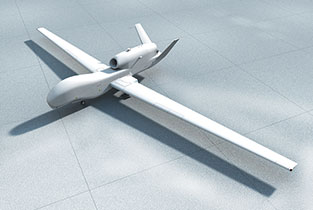
Putting UAS Standards to the Test
FAA and Kansas State University Salina Sign Memorandum of Agreement
Kansas State University Salina is one of the first universities in the United States to offer a bachelor of science degree in unmanned aircraft systems. Now, K-State Salina has begun a program to validate standards developed by ASTM International Committee F38 on Unmanned Aircraft Systems. The program is the result of a memorandum of agreement signed by K-State Salina and the U.S. Federal Aviation Administration on Aug. 29, 2013.
According to Mark Blanks, UAS program manager, Applied Aviation Research Center, K-State Salina, the small UAS category of aircraft represents a diverse range of vehicles that weigh less than 55 pounds.
"These aircraft can be anything from a vehicle that fits in your hand to an aircraft that can fly for 24 hours, and we believe that the standards need to be checked for viability across this broad spectrum," says Blanks, who is the chairman of Subcommittee F38.02 on Flight Operations, under the jurisdiction of F38.
"The importance of testing the standards is that there needs to be some assurance that when an unmanned aircraft system complies with F38 standards, the system is truly safe to operate," Blanks says. "By testing the standards, we hope to reduce the amount of refinement the F38 standards need by testing them prior to full UAS integration into the national airspace and assure the FAA, UAS manufacturers and operators that a system that complies with the F38 standards is a safe, or airworthy, system."
Established in 2003, F38 includes over 115 members who represent 17 countries. The committee has developed more than 20 standards that cover many important aspects of UAS. Among the standards developed by F38 are:
K-State Salina worked toward initiation of the program by submitting to the FAA a white paper describing the need for validating the F38's standards and the desire to put representative UAS through a traditional airworthiness certification program. The work performed at K-State will either validate the standards or identify areas in which the standards need to be modified.
"If we are able to validate the standards, it would mean that a UAS could be certified, and subsequently used for commercial purposes, using the F38 standards as the certification basis, perhaps even before official rulemaking is completed," says Blanks. "If we find issues with the standards, we will provide a recommendation to the committee on how to improve them. Either way, the commercial operation of UAS should be well served by the results of our study."
F38 standards shown to ensure the safety of UAS operations will significantly help the UAS industry as the case is made for UAS integration into the National Airspace System.
"The F38 standards could greatly reduce the concerns of regulating authorities, as well as the public, on the safety of integrating these systems, while giving UAS manufacturers concrete requirements to which they must build their systems," says Blanks. "Standardization as a whole will greatly improve the quality and confidence in products, and unmanned aircraft systems are no exception."
 SN Home
SN Home Archive
Archive Advertisers
Advertisers Masthead
Masthead RateCard
RateCard Subscribe
Subscribe Email Editor
Email Editor